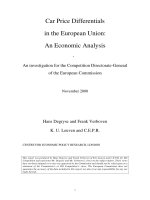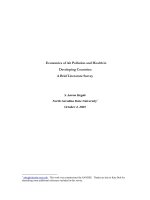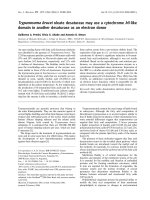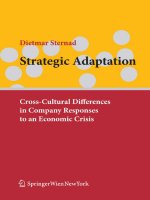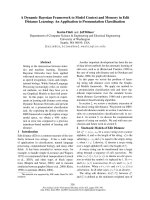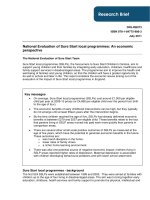COMPETITION AND COLLUSION IN ELECTRICAL EQUIPMENT MARKETS: AN ECONOMIC ASSESSMENT docx
Bạn đang xem bản rút gọn của tài liệu. Xem và tải ngay bản đầy đủ của tài liệu tại đây (2.69 MB, 133 trang )
COMPETITION
AND
COLLUSION IN ELECTRICAL
EQUIPMENT
MARKETS:
AN
ECONOMIC
ASSESSMENT
by
David
F.
Lean
Jonathan
D.
Ogur
Robert
P.
Rogers
Bureau
of
Economics
Staff
Report
to
the
Federal
Trade
Commission
July
1982
FEDERAL
TRADE
COMMISSION
JAMES
C.
MILLER
III,
Chairman
DAVID A.
CLANTON,
Commissioner
MICHAEL
PERTSCHUK,
Commissioner
PATRICIA
P.
BAILEY,
Commissioner
BUREAU
OF
ECONOMICS
ROBERT
D.
TOLLISON,
Director
RONALD
S.
BOND,
Deputy
Director
for
Operations
and
Research
JOHN
L.
PETERMAN,
Deputy
Director
for
Competition
RICHARD
HIGGINS,
Deputy
Director
for
Consumer
Protection
DAVID SCHEFFMAN,
Acting
Associate
Director
for
Special
Projects
WILLIAM
SHUGHART,
Special
Assistant
to
the
Director
THOMAS
WALTON,
Special
Assistant
to
the
Director
KEITH B.
ANDERSON,
Assistant
Director
for
Regulatory
Analysis
WENDY
GRAMM,
Assistant
Director
for
Consumer
Protection
PHILLIP
NELSON,
Acting
Assistant
Director
for
Competition
Analysis
PAULINE
IPPOLITO,
Assistant
Director
for
Industry
Analysis
JAMES
FE.RGUSON,
Assistant
Director
for
Antitrust
This
Report
has
been
prepared
by
the
Bureau
of
Economics
of
the
Federal
Trade
Commission.
It
has
not
been
reviewed
by
nor
does
it
necessarily
reflect
the
views
of
the
Commission
or
any
of
its
members.
-ii-
PREFACE
This
study
originated
in
the
1970'
s
-as
part
of
a
project
to
evaluate
economic
'performance
in
several
highly
concentrated
industries.
More
than
10
years
had
elapsed
since
the
widespread
price
fixing
and
antitrust
prosecution
of
electrical-equipment
companies
and
executives,
and
an
opportunity
existed
to
estimate
the
impacts
of
the
conspiracy
and
of
the
remedies.
Using
survey
data
obtained
from
the
manufactur'ers,'
the
study
seeks
information
to
help
answer
the
following
questions:
Did
conspiratorial
meet-
ings
permit
sellers
to
raise
profits,
other
things
equal?
Did
fines,
treble
damage
awards;
and
incarceration
cause
returns
to
fall
below
conspiracy
levels?
In
other
words,
how
effective
were
antitrust
conduct
remedies
in
improving
performance
in
an
oligopolistically
structured
industry?
Although
protracted
litigation
with
some
of
the
surveyed
companies
delayed
completion
of
the
study
for
several
years,
the
central
issues
of
oligopoly,
conspiracy,
and
antitrust
remain
relevant
to
both
makers
and
students
of
public
policy.
The
a,uthors
would
like
to
thank
the
many
Bureau
of
Economics
and
Office
of
the
General
Counsel
staff
members
who
made
important
contributions
to
this
study.
Numerous
Bureau
Directors
gave
their
support
to
the
study
at
critical
points,
starting
with
H.
Michael
Mann
and
continuing
with
F.
M.
Scherer,
Darius
W.
Gaskins
Jr.,
William
S.
Comanor,
Michael
P.
Lynch;
and
Robert
D.
Tollison.
-iii-
James
Dalton,
Robert
Larner,
and
Stephen
Rhoades
played
major
roles
in
formulating
the
original
research
design.
Thomas
Marx
made
significant
contributions
to
the-implementation
of
that
design.
During
the
protracted
litigation
that
followed,
Edward
Eitches,
Warren
Grimes,
and
Jerome
Tintle
provided
highly:
effec-
tive
legal
counsel,
and
Michael
Lynch
offered
useful
comments
and
advice
to
guide
the
data-collection
effort.
Once
the
data
were
obtained,
>John
Hamilton,
Emily
Robinson,
and
James
Sharpless
performed
extensive
processing
with
great
skill.
Joseph
Young
tabulated
certain
profit
data,
and
Barbara
Battle
rendered
additional
research
assistance.
Successive
drafts
of
the
reports
were
efficiently
typed
by
Vera
Chase,
Doris
Gudger,
Dianne
Jones,
Ken
Leyba,
Terri
Robl,
Dorothy
Tingen,
Darence
Wilson,
Walter
Wujcik,
and
Betsy
Zichterman.
Cary
Hoagland
and
Deborah
Ruggles
provided
accurate
editing
and
proofreading.
John
Kwoka,
John
Peterman,
Donald
Sant,
F.
M.
Scherer,
David
Ravenscraft,
William
Long,
James
Langenfeld,
and
Keith
Anderson
gave
incisive
critical
comments
and
suggestions
that
led
to
significant
improvements
in
the
study.
-iv-
TABLE
OF
CONTENTS
Chapter
Page
I.
Introduction.
1
II.
Structure-Conduct-Performance
Studies:
Issues
and
Models
. .
• •
10
III.
Collusion
and
profitability
in
Electrical-Equipment
Markets
25
IV.
Some
Extensions
of
the
Basic
Model
54
V.
Summary
and
Conclusions
74
References
83
Appendix
A:
The
Survey
and
the
Data
87
Appendix
B:
EEM
Survey
Documents
95
-v-
Table
III-I.
LIST
OF
TABLES
Regression
Results
for
the
Basic
Structure-
Conduct-Performance
Model,
1957-70
111-2.
Regression
Results
for
the
Basic
Model
With
Page
46
Bias
Correction,
1950-70
• • . . • • • .
51
IV-I.
participants
in
Electrical
Equipment
Conspiracies
59
IV-2.
IV-3.
1\1-4.
Regression
Results
for
an
Industry-Specific
Conspiracy
Model,
1957-70
• • . • •
Regression
Results
for
a
Participant/
Nonparticipant
Model,
1957-70
• . •
Regression
Results
for
a
Leader/Nonleader
Model,
1957-70
•.•••.•
V-I.
Estimated
Increase
in
Electrical
Equipment
Profit/Sales
Ratios
Due
to
Collusion
(In
Percentage
Points)
A-I.
Companies
Included
in
the
EEM
Study
-vi-
61
64
70
75
90
Chapter
I
INTRODUCTION
BACKGROUND
During
the
1950's,
more
than
30
electrical-equipment
manu-
facturers
engaged
in
an
elaborate
conspiracy
to
fix
prices
charged
utilities.
1
The
conspirators'
illegal
meetings
covered
20
product
lines
(including,
for
example,
steam
turbine
generators,
demand
and
watt-hour
meters,
and
power
circuit
breakers)
with
annual
sales
approaching
$2
billion.
After
TVA
complaints
about
identi-
cal
sealed
bids,
Justice
Department
investigations
began
in
1959,
and
a
grand
jury
handed
down
indictments
in
the
next
year.
As
the
result
of
successful
prosecution
under
the
Sherman
Act's
section
I,2
conspiring
companies
and
individual
officers
received
fines
exceeding
$1
million,
and
some
executives
were
given
jail
sentences.
Subsequently,
State
and
local
governments
and
privately
owned
utilities
sued
the
equipment
makers
for
damages
imposed
by
conspiracy-raised
prices.
The
resulting
refunds
reduced
manufacturers'
after-tax
incomes
in
the
early
1960's
by
more
than-$150
million.
3
By
historical
standards,
these
penalties
were
severe,
likely
to
have
a
significant
impact
on
seller
1
For
a
description
of
the
electrical
equipment
conspiracies,
see
Herling
(1962)
and
Walton
and
Cleveland
(1964).
2
Section
I
forbids
"every
contract,
combination
• • •
or
con-
spiracy
in
restraint
of
trade
or
commerce
among
the
several
States."
As
interpreted
by
the
courts,
the
section
makes
agree-
ments
to
fix
prices
per
se
illegal
(Scherer
1980,
p.
497).
3
See
ch.
III.
conduct.
Available
evidence
indicates
that
conspiratorial
meetings
ended
in
1959
and
have
not
been
resumed
(Ohio
Valley
Electric
et
al
v.
General
Electric
et
aI,
1976,
p.
3).
PURPOSE
OF
THE
STUDY
A
central
purpose
of
this
study
is
to
examine
the
impacts
of
conspiracy
and
subsequent
antitrust
"conduct"
remedies
on
per-
formance
in
electrical-equipment
markets.
l
We
attempt
to
address
the
issues
of
whether
price
fixing
caused
measurable
overcharges
for
electrical
equipment
and
whether
the
remedies
imposed
were
an
effective
response
to
the
problem.
Despite
the
passage
of
more
than
20
years
since
the
conspira-
cies
were
exposed,
the
question
of
their
effectiveness
remains
open.
In
the
course
of
numerous
damage
sUits,2
utilities
argued,
and
the
courts
generally
agreed,
that
conspiratorial
meetings
had
succeeded
in
raising
equipment
prices
(Bane
1973).
On
the
other
side,
manufacturers
(U.&.
Senate
1961)
and
Sultan
(1974
and
1975)
have
asserted
that
because
of
uncontrollable
cheating
on
agree-
ments,
the
sessions
failed
to
increase
prices.
3
From
a
theoretical
point
of
view,
conspiratorial
meetings
may
or
may
not
raise
seller
prices
and
profitability
significantly
1
Conduct
remedies,
such
as
fines,
jail
terms,
and
damage
pay-
ments,
seek
to
influence
industry
performance
by
changing
seller
conduct
but
make
no
attempt
to
modify
industry
structure.
2
See
ch.
III.
3
Sultan's
strongest
evidence,
however,
supports
a
successful
conspiracy.
See
ch.
II.
-2-
above
the
levels
otherwise
achieved.
Improved
interfirm
communi-
cation
through
these
face-to-face
gatherings
could
lead
to
stronger
price
agreements
and
higher
profits
than
otherwise.
The
success
of
meetings
may
depend,
however,
on
industry
structure
characteristics.
For
example,
at
least
moderate
levels
of
concen-
tration
are
probably
needed
to
allow
effective
policing
of
any
price
agreements
worked
out
in
meetings.
Extremely
high
concen-
tration
levels,
however,
may
allow
maximum
industry
profits
to
be
approached
without
explicit
collusion for
example,
through
market
signaling.
l
If
industry
profits
are
already
about
as
high
as
possible,
meetings
may
have
no
significant
effect
on
participants'
returns.
In
other
instances,
despite
moderate
to
high
concentra-
tion,
high
fixed
costs
and
sharp
cyclical
demand
fluctuations
may
prevent
profit
elevation
by
conspiracy,
signaling,
or
any
other
form
of
seller
conduct.
2
The
effectiveness
of
an
antitrust
policy
aimed
at
ending
explicit
collusion
depends
on
the
impact
of
conspiratorial
meetings
relative
to
that
of
other
pricing
methods.
If
price-
fixing
sessions
succeed
in
raising
participants'
returns
compared
to
alternative
pricing
mechanisms,
then
by
ending
the
gatherings,
antitrust
will
eliminate
the
added
monopoly
profits.
Where
concentration
is
high
enough
to
make
signaling
as
effective
as
I
Market
signaling
can
be
thought
of
as
the
attempt
by
rival
sellers
to
increase
prices
through
communication
in
the
public
media
rather
than
by
conspiratorial
meetings.
2
See
ch.
III.
-3-
meetings,
however,
antitrust
directed
at
the
meetings
alone
will
have
no
observable
impact
on
profit
performance.
Under
other
circumstances,
where
an
unfavorable
market
structure
thwarts
both
meetings
and
signaling
so
that
neither
method
achieves
higher
profitability,
antitrust
will
again
have
no
effect.
In
addition
to
being
unsettled
questions,
the
impacts
of
con-
spiracy
and
conduct
remedies
on
electrical-equipment
markets
are
important
ones.
Proper
implementation
of
antitrust
policy
in
the
future
requires
information
on
the
successes
and
failures
of
past
applications.
The
electrical-equipment
conspiracies
represent
one
of
the
most
widespread,
dramatic
violations
of
the
Sherman
Act's
Section
1.
The
conduct
remedies
imposed
were
among
the
strongest
ever.
Thus,
these
conspiracies
and
the
policy
response
present
an
opportunity
to
examine
the
impacts
of
such
actions
in
bold
relief.
Along
with
the
relationship
of
conspiracy
and
conduct
remedies
to
profitability,
we
examine
other
important
industrial-
organization
and
antitrust
policy
issues.
Among
them
are
the
importance
of
price-raising
versus
cost-reducing
effects
of
\
concentration,
the
significance
of
strategic
groups
in
producer
goods
markets,
and
the
role
of
the
third-largest
firm
in
promoting
competition.
Our
results
provide
additional
useful
information
on
these
questions in
part
because
previous
studies
have
rarely
analyzed
them
using
data
as
disaggregated
as
those
of
the
present
inquiry.
-4-
THE
SAMPLE
Of
the
20
product
markets
in
which
conspiracy
was
uncovered,
this
study
examines
8.
1
The
chosen
markets
account
for
just
over
60
percent
of
total
sales
affected
by
the
electrical-equipment
conspiracies.
All
8
are
highly
concentrated,
with
two-firm
concentration
ratios
ranging
from
just
under
50
to
nearly
100
over
the
1950-70
period.
They
vary
substantially,
however,
in
terms
of
such
other
structural
characteristics
as
standardization
of
the
product,
foreign
competition,
and
the
ratio
of
fixed
to
variable
costs
in
the
production
process.
The
eight
product
markets
included
in
our
study
can
be
described
briefly
as
follows:
(1)
Steam
turbine
generators
are
very
large,
multimillion-
dollar
machines,
generally
custom
built
to
utility
specifications
and
used
to
produce
electricity;
(2)
Steam
surface
condensers
are
large,
custom-built
tanks,
employed
in
connection
with
steam
turbine
generators
to
recycle
the
steam
that
drives
the
turbine;
(3)
Power
transformers
are
big
voltage-changing
devices
that
permit
more
efficient
transmission
of
electricity
over
long
dis-
tances
(while
the
largest
sizes
are
custom
built,
smaller
standardized
units
are
sold
from
inventory);
lOur
selection
was
made
primarily
on
the
basis
of
market
size
and
in
an
attempt
to
include
some
industry
structure
diversity
in
the
sample.
However,
we
omitted
such
large
product
groups
as
industrial
controls
and
low-voltage
distribution
equipment,
which
include
too
great
a
variety
of
products
for
effective
analysis
as
economic
markets.
-5-
'
(4)
Distribution
transformers
are
small,
standardized,
voltage-changing
devices
that
permit
safe
electricity
distribution
and
use,
(5)
Power
eircuit
breakers
are
devices
that
interrupt
the
flow
of
electric
current
to
prevent
equipment
damage
in
the
event
of
an
overload
or
short
circuit
(while
the
largest
units
are
custom
made,
smaller
breakers
are
standardized
and
sold
from
inventory)
,
(6)
Power
capacitors
are
devices
that
help
overcome
line
voltage
drops,
permitting
more
efficient
transmission
of
electricity
(although
sold
off
the
shelf,
these
devices
may
vary
in
quality
across
sellers),l
(7)
Insulators
are
porcelain
objects
used
to
hold
trans-
mission
lines,
while
preventing
the
electric
current
from
escaping
through-
the
supporting
poles
or
towers
into
the
ground
(this
standardized
product
is
produced
by
the
millions
annually
and
sold
from
inventory),
(8)
Demand
and
watt-hour
meters
are
devices
that
measure'
the
amount
of
power
used
by
electric
utilities'
individual
consumers
(these
meters
are
generally
standardized
and
sold
from
inventory)
•
Data
on
these
eight
products
were
collected
by
a
survey
of
35
respondent
firms.
Merger
and
acquisition
activity
over
the
1
Abel
1969,
p.
62.
-6-
years
gave
these
companies
access
to
a
number
of
other
electrical-
equipment
manufacturers'
records.
As a
result,
the
survey
obtained
data
for
about
70
firms
that
made
one
or
more
of
our
eight
products
during
the
1950-70
period,
which
contains
roughly
equal
years
of
conspiracy
(1950-59)
and
nonconspiracy
(1960-70).
The
resulting
sample
is
unique
in
that
it
contains
data
on
sales,
assets,
and
profits
at
a
highly
disaggregated
level
for
a
21-year
period.
With
this
sample,
we
can
examine
the
sources
of
high
seller
profitability
and
evaluate
the
impacts
of
conspiracy
and
subsequent
antitrust
remedies,
using
observations
that
more
closely
approximate
true
economic
markets
than
those
usually
available.
1
A
First'
Impression
of
Electrical-Equipment
Profitability
Using
our
survey
data,
we
can
obtain
a
rough
indication
of
of
electrical-equipment
profitability
patterns
over
the
1950-70
study
period.
For
this
purpose,
we
estimated
product-line
equity,
aggregated
equity
and
net
income
across
firms
in
each
market,
calculated
industry-level
after-tax
rates
of
return
on
equity,
and
lOur
data'
are
generally
less
aggregated
than
those
available
from
the
Bureau
of
the
Census
or
the
Internal
Revenue
Service.
(see
appendix
B).
Our
data
are
not
without
their
limitations,
however.
At
least
four
sources
of
error,
inconsistency,
or
omission
are
present:
(1)
differences
in
accounting
definitions
and
practices
across
companies
and
products,
(2)
changes
in
such
conventions
over
time,
(3)
estimation
errors
where
records
are
incomplete,
and
(4)
missing
observations
where
no
basis
for
estimation
exists.
Where
such
data
problems
introduce
predictable
biases
into
the
sample,
we
attempt
to
adjust
our
analysis
to
correct
for
them.
-7-
averaged
these
rates
of
return
over
the
1950's
and
over
the
1960's.1
To
reflect
(for
comparison
purposes)
the
profitability
patterns
of
u.s.
industry
in
general,
we
use
data
for
all
manufacturing
from
the
same
period.
2
If
we
consider
electrical-equipment
industry
profitability
relative
to
that
of
all
manufacturing,
different
pictures
emerge
for
the
1950's,
when
conspiratorial
meetings
were
held,
and
the
1960's,
the
posttrial
or
nonmeeting
period.
The
all-manufacturing
average
is
relatively
stable
over
the
entire
21-year
period;
all-manufacturing
average
after-tax
returns
on
equity
are
approximately
11
percent
for
each
of
the
two
decades.
By
contrast,
electrical-equipment
industry
returns
are
relatively
volatile.
During
the
1950's,
five
of
our
eight
product
markets
had
rates
of
return
greater
than
or
equal
to
20
percent.
These
highly
profitable
product
markets
are
turbine
generators,
me.ters,
power
transformers,
distribution
transformers,
and
power
circuit
breakers.
In
general,
from
the
1950'
s
to
the
1960'
s,
average
industry
profitability
fell in
some
cases
substantially.
During
the
1960's,
only
three
product
markets
had
returns
that
equaled
or
exceeded.20
percent.
These
markets
are
turbine
generators,
meters,
and
distribution
transformers.
Examination
of
data
for
1
Because
most
firms
in
our
sample
did
not
provide
equity
data
by
product
line,
we
allocated
total
company
equity
to
lines
on
the
basis
of
product-line
assets.
2
Profit
rates
for
all
manufacturing
are
based
on
FTC
Quarterly
Financial
Report
data
(see
The
Economic
Report
of
the
President,
1972,
p.
282).
-8-
individual
years
indicates,
moreover,
that
by
the
end
of
the
1960's,
only
the
meter
industry
was
able
to
earn
returns
well
above
the
all-manufacturing
average.
By'
contrast,
in
the
1960's,
power-circuit-breaker
profitability
fell
approximately
to
the
all-manufacturing
level
while
rates
of
return
in
power
transformers
dropped
below
that
average.
Finally,
the
insulator,
condenser,
and
power-capacitor
industries
were
unable
to
earn
average
returns
above
the
all-manufacturing
level
in
either
the
1950's
or
the
1960's.
How
should
these
rough
comparisons
be
interpreted?
Clearly,
one
cannot
draw
strong
conclusions
from
them
about
the
effective-
ness
or
ineffectiveness
of
conspiracy
and
antitrust
in
individual
electrical-equipment
markets.
Any
attempt
to
extract
such
conclu-
sions
would
ignore
the
numerous
other
determinants
of
profit-
ability
that
must
be
held
constant
to
identify
the
impacts
of
conspiracy
and
antitrust.
l
These
comparisons
are,
however,
suggestive
that
a
significant
change
in
electrical-equipment-
product
market
performance
may
have
occurred
at
the
time
when
antitrust
prosecution
brought
the
price-fixing
meetings
to
an
end.
Through
analysis
of
structure,
conduct,
and
performance,
the
remainder
of
this
study
presents
a
more
sharply
focused
look
at
the
impacts
of
conspiracy
and
antitrust
in
electrical
equipment.
1
For
example,
antitrust
damage
payments
reduced
postconspiracy
profits,
even
absent
a
change
in
seller
behavior.
.In
our
analysis
below,
we
correct
for
this
and
other
influences
on
profitability.
-9-
Chapter
II
STRUCTURE-CONDUCT-PERFORMANCE THEORIES:
ISSUES
AND
MODELS
In
this
ch~pter,
we
address
three
industrial-organization
questions
that
have
been
debated
in
previous
structure-conduct-
performance
analyses.
We
examine
the
impact
of
conspiracy
on
profitability:
is
pric.
fixing
a
profitable
activity
for
the
con-
spirators?
We
also
explore
the
concentration-profitability
rela-
tionship
to
shed
some
additional
light
on
its
meaning:
does
concentration
lead
to
higher
prices
or
lower
costs?
In
addition,
a
recently
posed
question
that
we
consider
is
the
importance
in
explaining
profitability
of
firms
following
common
strate_gies
within
industries.
For
each
of
these
issues,
we
survey
the
literature
briefly,
indicating
the
ways
in
which
the
present
study
will
contribute
to
that
literature.
Then,
we
present,
in
general
form,
the
regres-
sion
model
that
we
will
use
to
derive
our
results
in
chapters
III
and
IV.
DOES
CONCENTRATION
RAISE PRICE
OR
LOWER
COST?
Structure-conduct-performance
models
consist
of
a
set
of
relationships
between
industry-structure
characteristics
and
economic
performance,
through
the
intermediary
of
seller
conduct.
Since
Bain's
(1951)
pioneering
study,
a
voluminous
literature
analyzing
these
models
has
accumulated.
1
Most
of
these
analyses
1
For
a
survey
of
this
literature,
see
Weiss
1974.
-10-
focus
on
the
relationship
between
concentration
and
profitability.
In
general,
the
authors
found
evidence
of
a
positive
association
between
these
two
variables.
Where
a.few
sellers
control
a
relatively
lar~e
fraction
of
industry
output,
rates
of
return
tend
to
be
higher
than
the
level
that
would
prevail
in
a
less
concen-
trated
but
otherwise
identical
market.
Two
possible
explanations
have
been
advanced
for
a
positive
profitability-concentration
relationship:
the
price-elevation
hypothesis
and
the
cost-reduction
hypothesis.
l
The
price-
elevation
hypothesis
states
that
forming
and
maintaining
a
collu-
sive
agreement
is
easier
,in
a
concentrated
industry,'
because
the
number
of
participants
is
smaller
(Scherer
1980,
pp.
199-200).
As
a
result,
prices
are
likely
to
be
higher,
other
things
equal.
2
The
collusion
could
be
implemented
using
a
variety
of
interseller
communication
techn'iques,
ranging
from
market
signaling
to.
face-to-face
meetings.
According
to
the
cost-reduction
hypothesis,
concentrated
industries
are
characterized
by
economies
of
large-scale
'opera-
tion.
Such
advantages
of
large
firm
size
relative
to
the
market
1
The
discussion
of
these
alternative
explanations
is
based
largely
on
Scherer
(1980,
pp.
280-85).
2
Higher
prices
imply
greater
profitability,
provided
that
sell-
ers
do
not
permit
costs
to
rise
as
much
as
prices.
Assumed
away,
then,
is
inefficiency
in
the
absence
of
competitive
pressures,
i.e.,
Leibenstein's
x-inefficiency
(1966).
Also
ruled
out
is
the
seeking
of
such
nonprofit
management
goals
as
costly
workplace
amenities
(Williamson
1964,
and
Alchian
1965),
or
labor's
sharing
in
monopoly
profits
where
a
powerful
union
exists.
(See
Scherer
1980,
p.
463,
for
a
discussion
of
the
evidence
on
the
latter
relationship.)
-11-
389-306
0 -
82
- 2
can
arise
where
substantial
fixed
costs
must
be
incurred
in
order
to
sell
in
that
market.
In
a
research~and-development-intensive
industry,
for
example,
it
may
be
optimal-to
maintain
costly
test
facilities,
regardless
of
the
output
level
produced.
A
large
scale
of
production
permits
the
costs
of
those
facilities
to
be
spread
over
more
units
of
output,
thus
adding
less
to
the
cost
of
each
unit
than
would
be
added
at
a
smaller
scale.
Only
a
few
previous
studies
have
attempted
to
discriminate
between
these
two
explanations,
which
can
apply
simultaneously
to
the
same
industry.l
To
some
extent,
price-raising
and
cost-
reducing
effects
of
concentrated
market
structure
can
be
separated
by
including
both
an
industry-concentration
measure
and
a
market-
share
variable
in
a
structure-conduct-performance
model
(Scherer
1980,
p.
283).
Especially
in
homogeneous-product
industries,
where
price
variation
across
sellers
is
likely
to
be
minimal,
the
profitability/market-share
relationship
probably
captures
cost
differences
between
large
and
small
rivals.
In
that
event,
the
concentration
variable
should
reflect
primarily
the
price-raising
effect
of
collusion.
In
differentiated
product
markets,
this
conclusion.is
somewhat
weakened
by
the
possibility
that
large
sellers
may
also
have
advantages
in
convincing
buyers,
rightly
or
wrongly,
that
their
products
are
better
than
those
of
smaller
rivals
or
potential
entrants.
Such
large-firm
product
1
See,
for
example,
Demsetz
(1973),
Ravenscraft
'(1980),
and
the
studies
done
using
the
PIMS
data
set,
which
are
cited
in
Scherer
(1980,
p.
283
n.).
-12-
differentiation
advantages
may
translate
into
higher
prices
for
their
products
than
for
smaller
sellers'
output.
Although
these
large-seller
price
advantages
may
exis~
in
some
producer-goods
industries
(Lea~
1979),
they
are
probably
more
prevalent
in
consumer
product
markets.
In
addition,
to
the
extent
that
monop-
oly
power
is
related
to
market
share
(as
would
be
true,
for
example
under
a
dominant-firm.
model),
the
separation
of
price-
raising
from
cost-reducing
effects
of
concentration
becomes
more
difficult
to
achieve.
As
indicated
in
chapter
I,
our
·study
examines
eight
markets
in
which
utilities
purchase
producer
goods.
With
the
aid
of
their
own
engineering
staffs
and
outside
consultants,
the
buyers
of
these
products
are
relatively
well
informed.
As a
result,
any
product
differentiation
is
more
likely
to
reflect
real
perform-
ance
differences
in
these
markets
than
it
would
in
a
set
of
consumer-goods
markets.
l
Hence,
the
market-share
profitability
relationship
that
we
estimate
may
reflect
product
quality
and
monopoly-power
differences
as
well
as
cost
differences
between
large
and
small
sellers.
Nevertheless,
our
study
may
be
able
to
shed
some
additional
light
on
the
price-raising
and
cost-reducing
effects
of
concentration.
1
For
a
discussion
of
product
differentiation
in
the
case
of
power
capacitors,
see
Abel
(1969,
p.
62).
-13-
IS
CONSPIRACY
PROFITABLE?
Relatively
few
previous
studies
have
attempted
to
estimate
the
impact
of
conspiracy
on
profitability.for
markets
in
which
price
fixing
is
known
to
have
occurred
(see
Scherer
1980,
pp.
276-77).
In
these
analyses,
mixed,
zero,
or
even
negative
results
were
obtained.
As
explanations
of
their
failure
to
observe
a
strong
positive
relationship,
the
authors
suggest
problems
of
simultaneity
and
measurement
errors.
In
at
least
some
instances,
however,
other
possible
explanations
can
be
suggested.
Asch
and
Seneca
(1980)
examine
a
sample
that
includes
51
firms
that
were
found
guilty
of or
that
pleaded
nolo
contendere
to
Sherman
Act
conspiracy
charges
during
1958-67.
Also
included
in
their
sample
were
50
apparently
noncollusive
firms
chosen
at
random
from
Moody's
Industrials.
Although
the
authors
expected
to
observe
a
positive
conspiracy-profitability
relationship,
they
found
that
the
conspiring
firms
were
less
profitable
than
those
in
the
control
group,
other
things
being
equal.
Recognizing
that
causality
can
run
from
profitability
to
conspiracy
as
well
as
in
the
opposite
direction,
the
authors
suggest
by
way
of
explanation
that
price-fixing
attempts
may
be
a
response
to
poor
profit
per-
formance,
a
negative
relationship
consistent
with
their
findings.
This
explanation
suggests
the
need
to
develop
a
mUltiequation
model
in
which
conspiracy
is
endogenous
and
(perhaps)
a
function
-14-
of
previous-period
profitability,
while
also
being
an
explanator
of
present-period
rates
of
return.
l
Other
Asch
and
Seneca
findings
indicate
a
relationship
between
concentTation
and
conspiracy
that
could
account
(at
least
in
part)
for
their
observed
negative
conspiracy-profitability
result.
For
producer
goods,
they
found
a
negative
relationship
between
concentration
and
conspiracy,
which
could
reflect
the
use
of
explicit
price-fixing
when
concentration
is
too
low
to
permit
effective
tacit
collusion
or
market
signaling.
In
other
words,
conspirators'
profits
may
be
relatively
low
because
concentration,
in
markets
with
explicit
price-fixing,
is
also
low.
In
another
study,
Phillips
(1972)
makes
both
the
propensity
to
attempt
price
fixing
and
price
fixing's
effectiveness
endoge-
nous
variables,
with
each
a
function
of
profitability
and
the
industry-structure
characteristics:
number
of
sellers
and
number
of
trade
associations.
The
author
measures
the
attempts
to
fix
prices
by
the
number
of
trade
associations
reported
as
attempting
to
fix
prices
in
each
industry
of
a
sample
drawn
from
the
British
economy.
The
effectiveness
of
price
fixing
is
measured
by
a
sur-
vey
of
buyers'
judgments
on
the
issue.
The
author
hypothesizes
1
They
do
not,
however,
develop
and
estimate
such
a
model.
-15-
that
a
highly
effective
conspiracy
is
associated
with
high
prof-
its a
positive
relationship.l
In
addition,
Phillips
assumes
that
low
profitability
levels
reflect
recent
profit
decreases
that
tend
to
increase
the
aetempts
to
fix
prices a
negative
relationship
similar
to
that
proposed
by
Asch
and
Seneca
as
an
explanation
for
their
findings.
In
ordinary-least-squares
regressions,
Phillips
found,
however,
that
neither
of
his
conspiracy
variables
was
significantly
related
to
profitability a
result
that
he
suggests
may
be
attributed
to
reporting
errors.
Phillips'
two-stage-least-squares
results
are
mixed.
As
expected,
the
effectiveness
of
price
fixing
has
a
positive
coeffi-
cient
that
is
greater
than
its
standard
error
in
the
variou~
specifications
of
the
profitability
equation.
In
equations
that
explain
price-fixing
effectiveness
and
price-fixing
attempts,
how-
ever,
profitability
has
the
signs
predicted
by
Phillips,
but
its
coefficients
are
smaller
than
their
respective
standard
errors.
In
a
subsequent
two-volume
analysis
of
electrical
equipment
markets,
Sultan
estimates
the
impact
of
conspiracy
on
turbine-
generator
prices.
Largely
unconvinced
that
the
conspirators
suc-
ceeded
in
raising
these
prices,
the
author
follows
earlier
writers
by
recognizing
that
reverse
causality
may
also
exist,
so
that
1 He
also
assumes
that
high
profits
reduce
the
incentive
to
cheat
on
collusive.
agreements
(and
thus
increase
the
effectiveness
of
conspiracy).
The
latter
assumption
can
be
questioned,
however,
be~ause
high
prices
increase
the
return
to
the
individual
successful
cheater
and,
by
inducing
more
rapid
entry,
reduce
the
return
to
those
who
maintain
the
agreed-upon
price.
See
Scherer
(1980,
pp.
172-73).
-16-
price
levels
may
have
determined
whether
meetings
were
held.
l
By
contrast
with
the
previous
authors,
who
assumed
that
low
or
declining
profits
stimulate
conspiracy,.
Sultan
suggests
that
high
prices,
due
(for.
example)
to
strong
demand,
cause
conspirators
to
persist,
under
the
apparently
mistaken
impression
that
their
meetings
are
effective
(1975,
p.
111).2
In
other
words,
while
Asch
and
Seneca
as
well
as
Phillips
argue
that
low
profits
cause
conspiracy
(a
negative
relationship),
Sultan
suggests
that
high
prices
induce
meetings
(a
positive
association).
Nevertheless,
Sultan
estimates
a
model
based
on
the
assumption
that
conspiracy
raises
prices
and
finds
evidence
of
a
positive
but
insignificant
relationship
between
the
two
variables.
In
a
subsequent
simula-
tion
analysis,
however,
he
observes
a
significant
impact
of
conspiracy:
predicted
prices
for
a
model
that
includes
conspiracy
effects
are
8
or
9
percent
higher
than
those
for
a
model
without
conspiracy
(1975,
p.
348).
As
indicated
in
the
preceding
discussion,
recognition
of
simultaneity
between
conspiracy
and
profitability
suggests
the
1
Sultan,
however,
apparently
did
not
test
for
the
impact
of
price
levels
on
conspiracy.
His
use
of
conspiracy
variables
simi-
lar
to
those
of
the
present
study
(dummy
variables
representing
5-
or
lO-year
conspiracy
periods)
probably
precludes
such
a
test.
To
test
for
this
reverse
causality
would
probably
require
that
conspiracy
be
defined
in
terms
of,
say,
number
of
meetings
per
year,
or
even
analyzed
on
a
meeting-by-meeting
basis,
using
the
individual
transactions
discussed
at
each
meeting.
2
During
the
downswing,
Sultan
argues,
when
weak
demand
causes
falling
prices,
conspirators
recognize
their
ineffectiveness
and
stop
meeting.
-17-
development
and
estimation
of
a
mUltiequation
model
in
which
both
variables
are
determined
endogenously.
To
the
best
of
our
knowl-
edge,
only
Phillips
has
developed
and
estimated
such
a
model.
Other
authors,
however,
have
analyzed
mUltiequation
structure-
conduct-performance
models,
which
(although
they
do
not
include
a
conspiracy
variable)
nevertheless
provide
useful
insights.
In
previous
studies
by
Strickland
and
Weiss
(1976),
Martin
(1979),
and
pagoulatos
and
Sorenson
(1981),
three-equation
structure-
conduct-performance
models
were
estimated,
in
which
profitability,
concentration,
and
advertising
intensity
are
treated
as
endogenous
variables.
These
models
represent
an
econometric
advance
over
single-equation
ones
in
that
simUltaneous-equation
bias
is
avoided.
From
comparison
of
their
results
to
those
from
single-
equation
estimation,
however,
the
authors
suggest
that
such
bias
may
be
unimportant
(Strickland
and
Weiss,
p.
1109),
or
no
more
important
than
the
bias
due
to
the
omission
of
relevant
explana-
tory
variables
(Martin,
p.
646).
With
regard
to
the
problem
of
omitted
variables,
Maddala
(1977,
p.
231)
suggests
that
the
ordinary-least-squares
method,
which
is
often
used
to
estimate
single-equation
models,'
has
been
found,
in
general,
to
be
more
robust
against
specification
errors
than
many
simultaneous-equation
methods.
Lacking
rigorous
theoretical
models
to
indicate
the
correct
specification,
structure-conduct-performance
regression
models
almost
certainly
omit
relevant
explanatory
variables
and
are
subject
to
other
-18-


